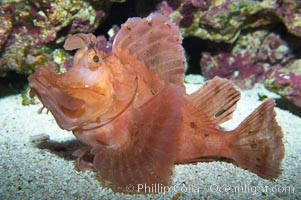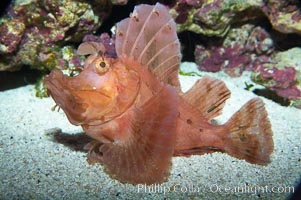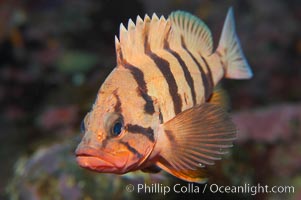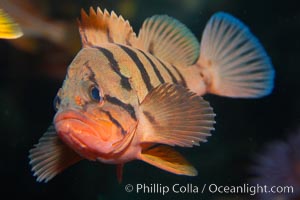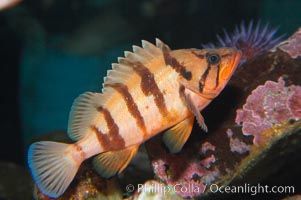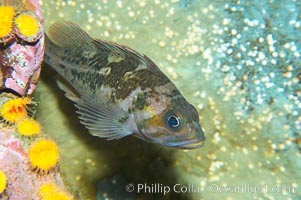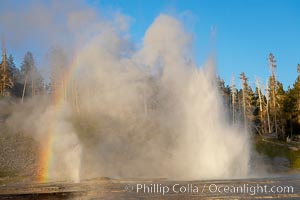
A rainbow forms in the mist from Grand Geyser and Vent Geyser. Grand Geyser is a fountain-type geyser reaching 200 feet in height and lasting up to 12 minutes. Grand Geyser is considered the tallest predictable geyser in the world, erupting about every 12 hours. It is often accompanied by burst or eruptions from Vent Geyser and Turban Geyser just to its left. Upper Geyser Basin.
Location: Upper Geyser Basin, Yellowstone National Park, Wyoming
Image ID: 13452
Location: Upper Geyser Basin, Yellowstone National Park, Wyoming
Image ID: 13452
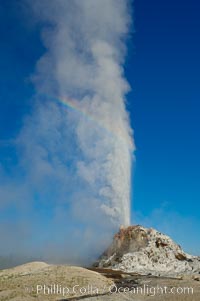
White Dome Geyser, with a faint rainbow visible in its mist, rises to a height of 30 feet or more, and typically erupts with an interval of 15 to 30 minutes. It is located along Firehole Lake Drive.
Location: Lower Geyser Basin, Yellowstone National Park, Wyoming
Image ID: 13541
Location: Lower Geyser Basin, Yellowstone National Park, Wyoming
Image ID: 13541
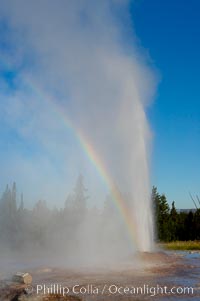
A rainbow appears in the spray of Pink Cone Geyser. Pink Cone Geyser reaches 30 feet in height, and has highly variable interval and duration. It is a cone-type geyser and its cone has a pinkish tint due to manganese oxide in it. Firehole Lake Drive, Lower Geyser Basin, Yellowstone Park.
Location: Lower Geyser Basin, Yellowstone National Park, Wyoming
Image ID: 13549
Location: Lower Geyser Basin, Yellowstone National Park, Wyoming
Image ID: 13549
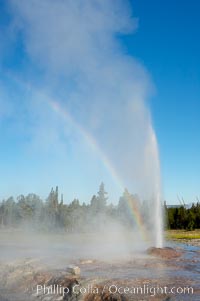
A rainbow appears in the spray of Pink Cone Geyser. Pink Cone Geyser reaches 30 feet in height, and has highly variable interval and duration. It is a cone-type geyser and its cone has a pinkish tint due to manganese oxide in it. Firehole Lake Drive, Lower Geyser Basin, Yellowstone Park.
Location: Lower Geyser Basin, Yellowstone National Park, Wyoming
Image ID: 13553
Location: Lower Geyser Basin, Yellowstone National Park, Wyoming
Image ID: 13553
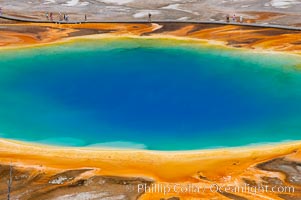
Grand Prismatic Spring displays a stunning rainbow of colors created by species of thermophilac (heat-loving) bacteria that thrive in narrow temperature ranges. The blue water in the center is too hot to support any bacterial life, while the outer orange rings are the coolest water. Grand Prismatic Spring is the largest spring in the United States and the third-largest in the world. Midway Geyser Basin.
Location: Midway Geyser Basin, Yellowstone National Park, Wyoming
Image ID: 13572
Location: Midway Geyser Basin, Yellowstone National Park, Wyoming
Image ID: 13572
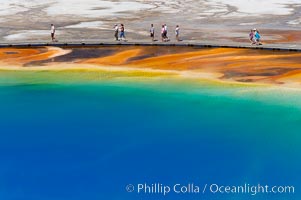
Grand Prismatic Spring displays a stunning rainbow of colors created by species of thermophilac (heat-loving) bacteria that thrive in narrow temperature ranges. The blue water in the center is too hot to support any bacterial life, while the outer orange rings are the coolest water. Grand Prismatic Spring is the largest spring in the United States and the third-largest in the world. Midway Geyser Basin.
Location: Midway Geyser Basin, Yellowstone National Park, Wyoming
Image ID: 13574
Location: Midway Geyser Basin, Yellowstone National Park, Wyoming
Image ID: 13574
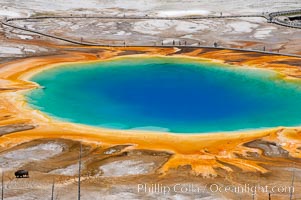
Grand Prismatic Spring displays a stunning rainbow of colors created by species of thermophilac (heat-loving) bacteria that thrive in narrow temperature ranges. The blue water in the center is too hot to support any bacterial life, while the outer orange rings are the coolest water. Grand Prismatic Spring is the largest spring in the United States and the third-largest in the world. Midway Geyser Basin.
Location: Midway Geyser Basin, Yellowstone National Park, Wyoming
Image ID: 13575
Location: Midway Geyser Basin, Yellowstone National Park, Wyoming
Image ID: 13575
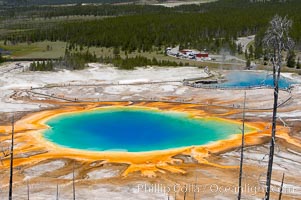
Grand Prismatic Spring (left) and Excelsior Geyser (right). Grand Prismatic Spring displays a stunning rainbow of colors created by species of thermophilac (heat-loving) bacteria that thrive in narrow temperature ranges. The blue water in the center is too hot to support any bacterial life, while the outer orange rings are the coolest water. Grand Prismatic Spring is the largest spring in the United States and the third-largest in the world. Midway Geyser Basin.
Location: Midway Geyser Basin, Yellowstone National Park, Wyoming
Image ID: 13576
Location: Midway Geyser Basin, Yellowstone National Park, Wyoming
Image ID: 13576
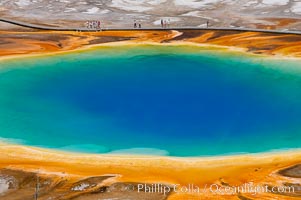
Grand Prismatic Spring displays a stunning rainbow of colors created by species of thermophilac (heat-loving) bacteria that thrive in narrow temperature ranges. The blue water in the center is too hot to support any bacterial life, while the outer orange rings are the coolest water. Grand Prismatic Spring is the largest spring in the United States and the third-largest in the world. Midway Geyser Basin.
Location: Midway Geyser Basin, Yellowstone National Park, Wyoming
Image ID: 13577
Location: Midway Geyser Basin, Yellowstone National Park, Wyoming
Image ID: 13577
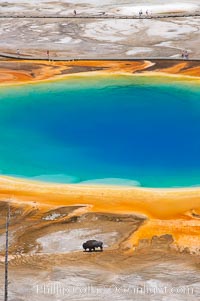
Grand Prismatic Spring displays a stunning rainbow of colors created by species of thermophilac (heat-loving) bacteria that thrive in narrow temperature ranges. The blue water in the center is too hot to support any bacterial life, while the outer orange rings are the coolest water. Grand Prismatic Spring is the largest spring in the United States and the third-largest in the world. Midway Geyser Basin.
Location: Midway Geyser Basin, Yellowstone National Park, Wyoming
Image ID: 13578
Location: Midway Geyser Basin, Yellowstone National Park, Wyoming
Image ID: 13578
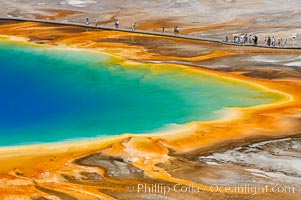
Grand Prismatic Spring displays a stunning rainbow of colors created by species of thermophilac (heat-loving) bacteria that thrive in narrow temperature ranges. The blue water in the center is too hot to support any bacterial life, while the outer orange rings are the coolest water. Grand Prismatic Spring is the largest spring in the United States and the third-largest in the world. Midway Geyser Basin.
Location: Midway Geyser Basin, Yellowstone National Park, Wyoming
Image ID: 13579
Location: Midway Geyser Basin, Yellowstone National Park, Wyoming
Image ID: 13579
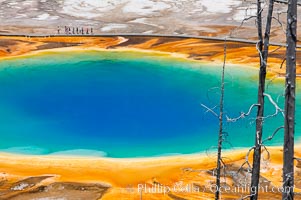
Grand Prismatic Spring displays a stunning rainbow of colors created by species of thermophilac (heat-loving) bacteria that thrive in narrow temperature ranges. The blue water in the center is too hot to support any bacterial life, while the outer orange rings are the coolest water. Grand Prismatic Spring is the largest spring in the United States and the third-largest in the world. Midway Geyser Basin.
Location: Midway Geyser Basin, Yellowstone National Park, Wyoming
Image ID: 13580
Location: Midway Geyser Basin, Yellowstone National Park, Wyoming
Image ID: 13580
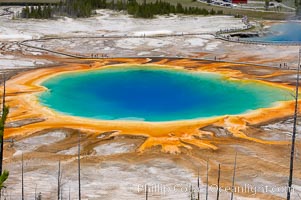
Grand Prismatic Spring (left) and Excelsior Geyser (right). Grand Prismatic Spring displays a stunning rainbow of colors created by species of thermophilac (heat-loving) bacteria that thrive in narrow temperature ranges. The blue water in the center is too hot to support any bacterial life, while the outer orange rings are the coolest water. Grand Prismatic Spring is the largest spring in the United States and the third-largest in the world. Midway Geyser Basin.
Location: Midway Geyser Basin, Yellowstone National Park, Wyoming
Image ID: 13581
Location: Midway Geyser Basin, Yellowstone National Park, Wyoming
Image ID: 13581
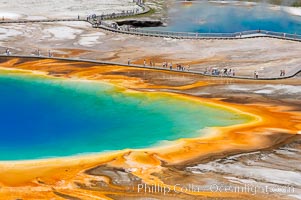
Grand Prismatic Spring displays a stunning rainbow of colors created by species of thermophilac (heat-loving) bacteria that thrive in narrow temperature ranges. The blue water in the center is too hot to support any bacterial life, while the outer orange rings are the coolest water. Grand Prismatic Spring is the largest spring in the United States and the third-largest in the world. Midway Geyser Basin.
Location: Midway Geyser Basin, Yellowstone National Park, Wyoming
Image ID: 13582
Location: Midway Geyser Basin, Yellowstone National Park, Wyoming
Image ID: 13582
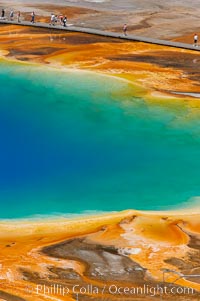
Grand Prismatic Spring displays a stunning rainbow of colors created by species of thermophilac (heat-loving) bacteria that thrive in narrow temperature ranges. The blue water in the center is too hot to support any bacterial life, while the outer orange rings are the coolest water. Grand Prismatic Spring is the largest spring in the United States and the third-largest in the world. Midway Geyser Basin.
Location: Midway Geyser Basin, Yellowstone National Park, Wyoming
Image ID: 13583
Location: Midway Geyser Basin, Yellowstone National Park, Wyoming
Image ID: 13583
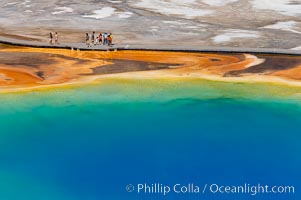
Grand Prismatic Spring displays a stunning rainbow of colors created by species of thermophilac (heat-loving) bacteria that thrive in narrow temperature ranges. The blue water in the center is too hot to support any bacterial life, while the outer orange rings are the coolest water. Grand Prismatic Spring is the largest spring in the United States and the third-largest in the world. Midway Geyser Basin.
Location: Midway Geyser Basin, Yellowstone National Park, Wyoming
Image ID: 13584
Location: Midway Geyser Basin, Yellowstone National Park, Wyoming
Image ID: 13584
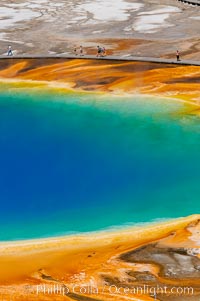
Grand Prismatic Spring displays a stunning rainbow of colors created by species of thermophilac (heat-loving) bacteria that thrive in narrow temperature ranges. The blue water in the center is too hot to support any bacterial life, while the outer orange rings are the coolest water. Grand Prismatic Spring is the largest spring in the United States and the third-largest in the world. Midway Geyser Basin.
Location: Midway Geyser Basin, Yellowstone National Park, Wyoming
Image ID: 13585
Location: Midway Geyser Basin, Yellowstone National Park, Wyoming
Image ID: 13585
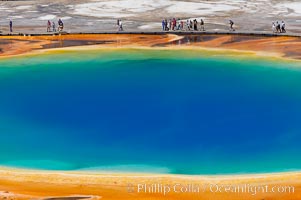
Grand Prismatic Spring displays a stunning rainbow of colors created by species of thermophilac (heat-loving) bacteria that thrive in narrow temperature ranges. The blue water in the center is too hot to support any bacterial life, while the outer orange rings are the coolest water. Grand Prismatic Spring is the largest spring in the United States and the third-largest in the world. Midway Geyser Basin.
Location: Midway Geyser Basin, Yellowstone National Park, Wyoming
Image ID: 13586
Location: Midway Geyser Basin, Yellowstone National Park, Wyoming
Image ID: 13586
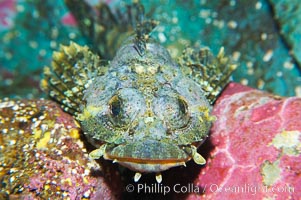
Red Irish Lord. The red irish lord lurks in shallow habitats where it feeds on crabs, shrimp, barnacles, mussels and small fishes.
Species: Red irish lord, Hemilepidotus hemilepidotus
Image ID: 13690
Species: Red irish lord, Hemilepidotus hemilepidotus
Image ID: 13690
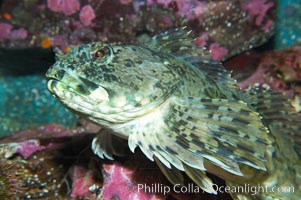
Cabazon. Large cabazons sometimes lie camoflaged on top of deep rocky outcroppings. Juveniles are often found in shallow water.
Species: Cabezon, Scorpaenichthys marmoratus
Image ID: 13691
Species: Cabezon, Scorpaenichthys marmoratus
Image ID: 13691
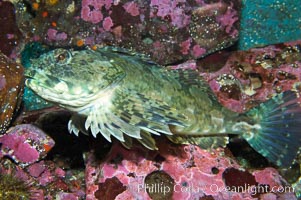
Cabazon. Large cabazons sometimes lie camoflaged on top of deep rocky outcroppings. Juveniles are often found in shallow water.
Species: Cabezon, Scorpaenichthys marmoratus
Image ID: 13692
Species: Cabezon, Scorpaenichthys marmoratus
Image ID: 13692
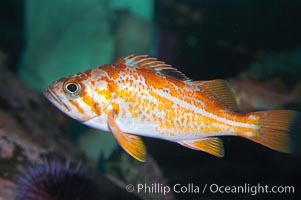
Canary rockfish, juvenile. The bright orange color of this rockfish will not be so visible at depth, where seawater filters out the red lightwaves that allow this color to be seen.
Species: Canary rockfish, Sebastes pinniger
Image ID: 13695
Species: Canary rockfish, Sebastes pinniger
Image ID: 13695
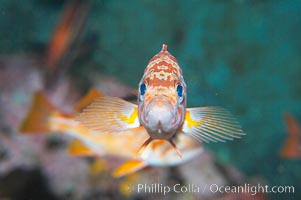
Canary rockfish, juvenile. The bright orange color of this rockfish will not be so visible at depth, where seawater filters out the red lightwaves that allow this color to be seen.
Species: Canary rockfish, Sebastes pinniger
Image ID: 13696
Species: Canary rockfish, Sebastes pinniger
Image ID: 13696
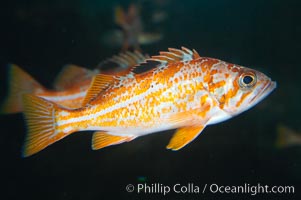
Canary rockfish, juvenile. The bright orange color of this rockfish will not be so visible at depth, where seawater filters out the red lightwaves that allow this color to be seen.
Species: Canary rockfish, Sebastes pinniger
Image ID: 13697
Species: Canary rockfish, Sebastes pinniger
Image ID: 13697
